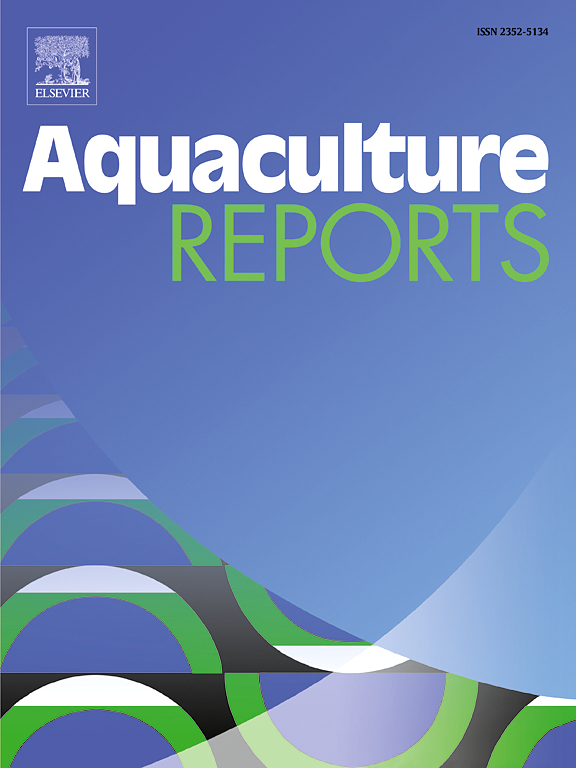Archidendron clypearia extract: Modulating intestinal inflammation and enhancing disease resistance in aquacultured American bullfrogs (Aquarana catesbeiana)
IF 3.7
2区 农林科学
Q1 FISHERIES
引用次数: 0
Abstract
Intestinal inflammation and bacterial infections challenges in the aquaculture of American bullfrogs (Aquarana catesbeiana), impacting their health and productivity. Archidendron clypearia, a traditional Chinese medicinal plant, is known for its analgesic, antibacterial, anti-inflammatory, and antioxidant properties, suggesting its potential as an integrative therapeutic agent in aquaculture. In this study, a short-term feeding experiment (35 days) was designed to explore the effects of A. clypearia extract (AE), on growth, intestinal morphology, antioxidant status, immune function and intestinal flora of bullfrog fingerlings. After feeding, bullfrogs were experimentally infected with Elizabethkingia miricola and monitored for an additional 14 days. Four groups were fed a commercial diet supplied with different AE as 0, 0.2, 1.0, and 5.0 g/kg. Results showed significant improvements in the growth and intestinal morphology of AE-supplied groups compared to the control. Moreover, Dietary supplemented with AE significantly increased expression levels of the tight junction protein–related genes, including zonula occludens-1(ZO-1), zonula occludens-2 (ZO-2), zonula occludens-3 (ZO-3), occludin, and claudin-7. However, the expression of inflammation-related genes, including Interleukin-8 (IL-8), Interleukin-1β (IL-1β), C-X-C Motif Chemokine Ligand 10 (CXCL10), in the liver and intestine were significantly decreased in all AE groups compared to the controls (P < 0.05). Alternatively, no significant impact on blood indices and intestinal microflora in all experimental groups. After challenge, the survival rates in 0, 0.2, 1.0 and 5.0 g/kg groups were 10 %, 50 %, 80 % and 70 %, respectively, suggesting enhancement of the bullfrog resistance in AE groups compared to control. The results suggest the AE positively impacted growth performance and disease resistance, making it a potentially useful functional feed additive in bullfrog breeding. The results suggest that adding 1.0 g/kg AE to the diet positively impacted growth performance and disease resistance, making it a potentially useful functional feed additive in bullfrog breeding.
美洲水牛蛙(Aquarana catesbeiana)对肠道炎症的调节和抗病性的增强
美国牛蛙(Aquarana catesbeiana)养殖中肠道炎症和细菌感染的挑战,影响其健康和生产力。摘要灌浆Archidendron clypearia是一种传统的中药植物,具有镇痛、抗菌、抗炎、抗氧化等特性,具有作为水产养殖综合治疗剂的潜力。本试验采用短期饲养试验(35 d),研究牛蛙提取物(AE)对牛蛙幼体生长、肠道形态、抗氧化状态、免疫功能和肠道菌群的影响。喂食后,牛蛙实验性地感染了miricola伊丽莎白金氏菌,并对其进行了14天的监测。4组分别饲喂AE水平为0、0.2、1.0和5.0 g/kg的商品饲粮。结果显示,与对照组相比,ae组的生长和肠道形态有显著改善。此外,饲料中添加AE显著提高了紧密连接蛋白相关基因occludula -1(ZO-1)、occludula -2 (ZO-2)、occludula -3 (ZO-3)、occludin和claudin-7的表达水平。然而,与对照组相比,所有AE组肝脏和肠道中炎症相关基因,包括白细胞介素-8 (IL-8)、白细胞介素-1β (IL-1β)、C-X-C Motif趋化因子配体10 (CXCL10)的表达均显著降低(P <; 0.05)。各试验组对血液指标和肠道菌群均无显著影响。攻毒后,0、0.2、1.0和5.0 g/kg组的存活率分别为10 %、50 %、80 %和70 %,表明AE组的牛蛙抗性较对照组增强。结果表明,AE对牛蛙的生长性能和抗病性有积极的影响,是一种潜在的功能性饲料添加剂。由此可见,饲粮中添加1.0 g/kg AE对牛蛙的生长性能和抗病性有积极影响,是一种潜在的功能性饲料添加剂。
本文章由计算机程序翻译,如有差异,请以英文原文为准。
求助全文
约1分钟内获得全文
求助全文
来源期刊

Aquaculture Reports
Agricultural and Biological Sciences-Animal Science and Zoology
CiteScore
5.90
自引率
8.10%
发文量
469
审稿时长
77 days
期刊介绍:
Aquaculture Reports will publish original research papers and reviews documenting outstanding science with a regional context and focus, answering the need for high quality information on novel species, systems and regions in emerging areas of aquaculture research and development, such as integrated multi-trophic aquaculture, urban aquaculture, ornamental, unfed aquaculture, offshore aquaculture and others. Papers having industry research as priority and encompassing product development research or current industry practice are encouraged.
 求助内容:
求助内容: 应助结果提醒方式:
应助结果提醒方式:


